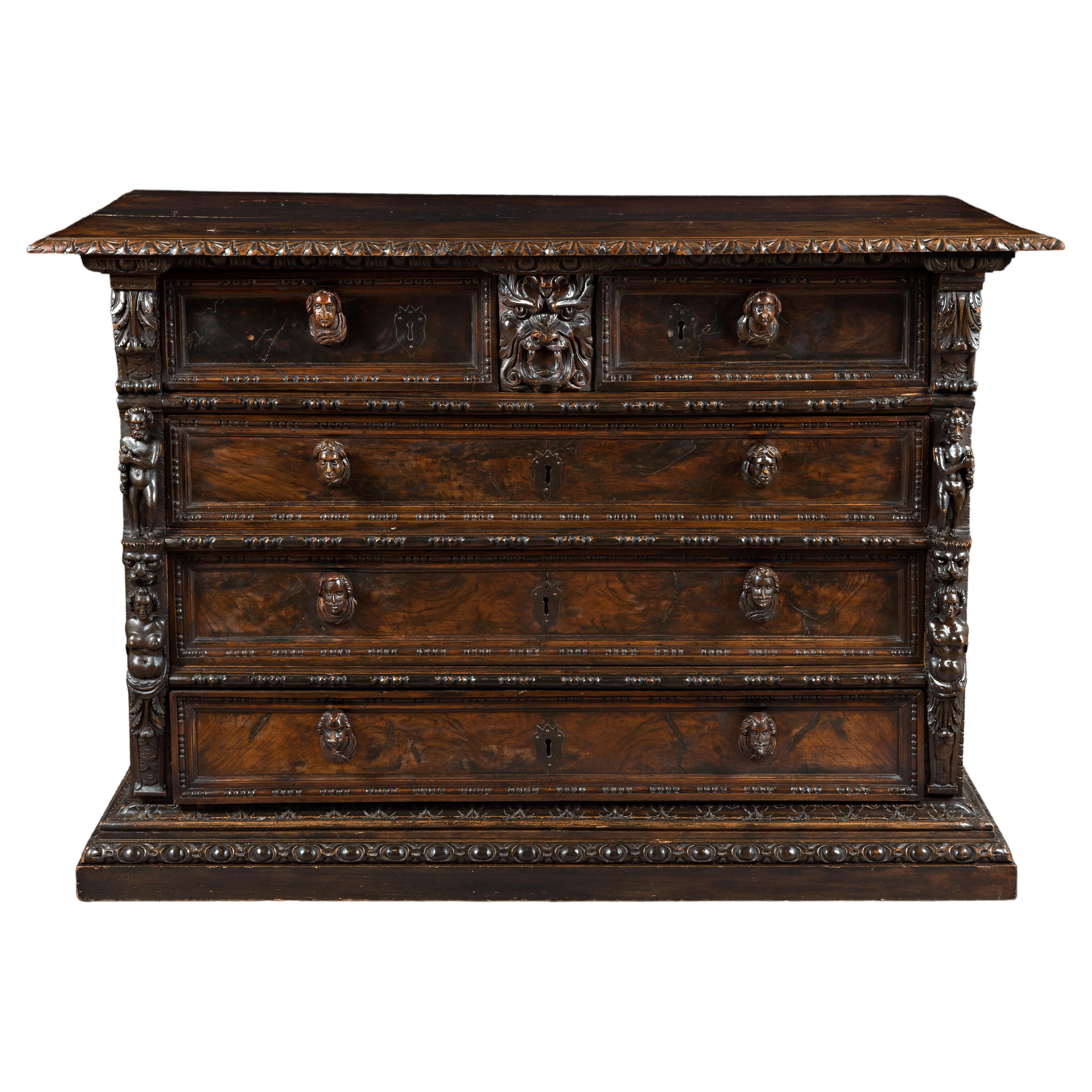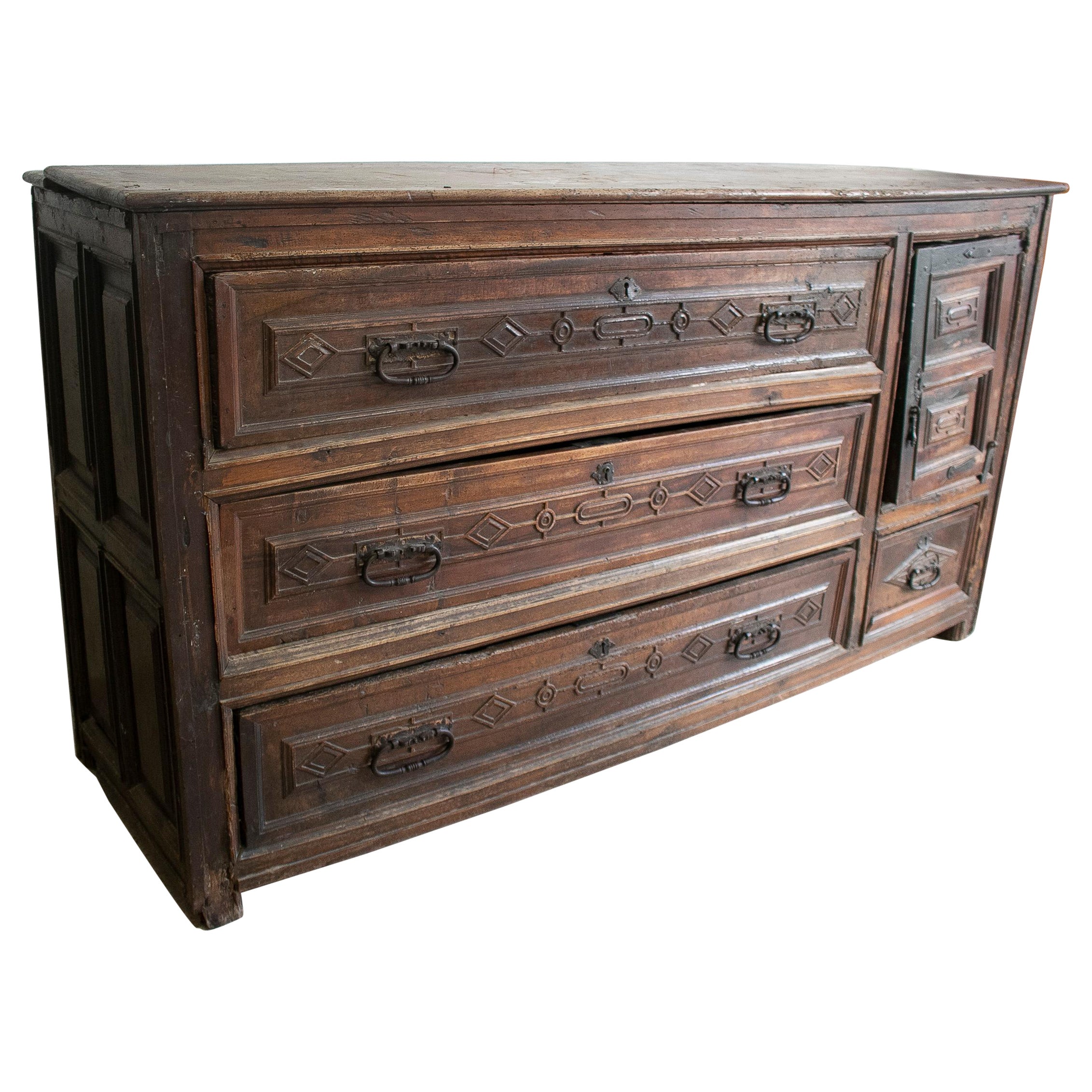Items Similar to Late 16th Century Siena Sacristy Chest of Drawer
Want more images or videos?
Request additional images or videos from the seller
1 of 10
Late 16th Century Siena Sacristy Chest of Drawer
About the Item
Beautiful small chest of drawers with four drawers in carved walnut with tiles both on the drawers and on the sides.
Typical Tuscan cabinet-making from the end of the 16th century, it is embellished with the carved and gilded finishes typical of the important furniture of that era. The chest of drawers comes from the private chapel of Villa L'Eremo near Florence, this villa of fifteenth-century origin still preserved high-age furnishings. Beautiful proportions and sizes that make this chest of drawers easy to place in any home.
- Dimensions:Height: 39.38 in (100 cm)Width: 31.5 in (80 cm)Depth: 29.53 in (75 cm)
- Materials and Techniques:
- Place of Origin:
- Period:
- Date of Manufacture:1590
- Condition:Minor losses. Minor fading. We remind you that for antique goods the courier will have to produce the necessary documentation to the Fine Arts.
- Seller Location:Firenze, IT
- Reference Number:1stDibs: LU7189232326032
About the Seller
5.0
Vetted Seller
These experienced sellers undergo a comprehensive evaluation by our team of in-house experts.
1stDibs seller since 2022
12 sales on 1stDibs
Typical response time: 15 hours
- ShippingRetrieving quote...Ships From: Firenze, Italy
- Return PolicyA return for this item may be initiated within 10 days of delivery.
More From This SellerView All
- Late 17th Century Tuscany Walnut Chest of DrawerLocated in Firenze, FIBeautiful small chest of drawers in solid walnut, slightly notched, top with bull's beak edge, three full-body drawers veneered in walnut with frames in solid walnut and knobs with b...Category
Antique Late 17th Century Italian Commodes and Chests of Drawers
MaterialsWalnut
- 16th Century Renaissance Florentine ChestLocated in Firenze, FIBeautiful model of chest in carved walnut with features typical of the late sixteenth century in Florence with the addition of parts decorated with grotesque lean tempera on a chalky background. Used as a small travel chest, it is complete with an antique lock...Category
Antique 16th Century Italian Renaissance Cabinets
MaterialsWood, Walnut
- SECOND HALF OF THE 16th CENTURY CHESTNUT CHESTLocated in Firenze, FIThe chest in question is an elegant piece of furniture made entirely of chestnut wood. Its manufacture dates back to the Renaissance, around the second half of the 16th century, by T...Category
Antique 16th Century Italian Renaissance Cabinets
MaterialsWood, Chestnut
- END OF THE 16th CENTURY LOUIS XIV TABLE WITH DRAWERLocated in Firenze, FIThis solid walnut side table is an exemplary testimony of Italian manufacturing from the late 17th century and the Louis XIV period. The craftsmanship and simple but refined style ty...Category
Antique Late 17th Century Italian Louis XIV End Tables
MaterialsWood, Nutwood
- EARLY 18th CENTURY PAIR OF CHESTS LOUIS XIVLocated in Firenze, FIElegant pair of walnut veneered chests of drawers with geometric motifs and ebonized wood finishes. The wavy front, the owl's beak shaped top and the shelf base give a unique eleganc...Category
Antique Early 18th Century Italian Louis XIV Commodes and Chests of Drawers
MaterialsNutwood
- 16th CENTURY GUARD'S STOOLLocated in Firenze, FITypical stool with backrest and curved legs in solid walnut wood with dark patina. This type of bench is used in guard posts, for this reason the seat is small and uncomfortable, to ...Category
Antique 16th Century Italian Renaissance Stools
MaterialsWood, Walnut
You May Also Like
- Late 16th Century Genoan Bambocci Chest of DrawersLocated in Saint-Ouen, FRProvenance: Gismondi collection, before 1973. Historical Context This walnut wood and walnut burl cassetone is a remarkable example of Mannerist art applied to furniture in the late 16th century. While the Mannerist movement appeared and grew in Florence before acquiring its international stature it also spread to Northern Italy as soon as the late 16th century early 17th century. To the opposite of the rest of Italy where classic motifs are adopted very early, northern regions maintain the use of Renaissance motifs very late all through the 17th century. Sculpture now leaving the austere environment of churches and civil buildings appear in private homes where it graces state rooms and studies. This craze is particularly expressed on furniture from Liguria and particularly in Genoa where are produced highly carved furnitures with figures and spectacular decors called bambocci. This typically Genoese pieces express nonetheless a Florentine origin through Mannerism. Description This Genoese chest is framed by small figures skilfully carved from one wood chunk...Category
Antique 16th Century Italian Renaissance Commodes and Chests of Drawers
MaterialsWalnut
- 16th Century English Drawer Chest w/ Original Iron FittingsLocated in Marbella, ESAntique 16th Century English drawer chest with original iron fittings.Category
Antique 16th Century Spanish Commodes and Chests of Drawers
MaterialsWalnut
- Cassettone or Bureau-Chest, Late 16th Century, Italian Renaissance, WalnutLocated in BUNGAY, SUFFOLKExceptional museum quality, Italian, renaissance walnut cassettone with fitted bureau in the upper part & exceptional Bambocci carving, Lombardy. This magnificent cassettone exudes the character and quality of the finest, late-Renaissance furniture. Late 16th century, Northern Italian furniture often had the sides, legs or angles, 'a Bambocci', incorporating carved figures which were unique sculptures in their own right. The putti on this cassettone are beautifully carved and of sculptural quality. Each angel has one arm raised to heaven, a poignant touch. Showing customary signs of wear from time, the lion’s paw feet make a great statement. This cassettone was conceived to have visual impact through the quality of the carving, as well as being very practical with the writing compartment fitted in the top part. It has survived in very original condition with a few small repairs and losses, and the color and patina are warm and lustrous. This cassettone was illustrated in one of the seminal works on Lombardy furniture in the 1969 and has been in two renowned collections. The hinged top in two sections faced with a solid moulded edge. The front part has a fall front and opens to reveal a writing compartment. The fall front retains its original lock and is concealed with a false drawer which is above three drawers. All with moulded panels, escutcheons and retaining the original iron handles. The front ends have exceptional, bambocci, carved putti raising their arms to heaven above trailing foliage. Standing on magnificent lion...Category
Antique 16th Century Italian Baroque Furniture
MaterialsWalnut
- Rare Late Medieval 16th Century German Wrought Iron Oak ChestLocated in grand Lancy, CHA very impressive Westphalian Gothic chest or ‚Stollentruhe’, Westphalia, Germany, circa 1500-1550. Wrought iron mounted oak, partially carved. The monumental rectangular standing ch...Category
Antique 16th Century German Commodes and Chests of Drawers
MaterialsIron
- French Louis the 16th Chest of DrawersLocated in Nashville, TNThis beautiful French Louis 16th chest with unique line detailing on the sides and a black and white marble top. Three oak lined drawers that slide perfectly. This classic piece woul...Category
Antique 19th Century Commodes and Chests of Drawers
MaterialsOak
- Rare Late Medieval 16th Century German Wrought Iron Oak Chest or StollentruheLocated in Worpswede / Bremen, DEA very impressive Westphalian Gothic chest or ‚Stollentruhe’, Westphalia, Germany, circa 1500-1550. Wrought iron mounted oak, partially carved. The monumental rectangular standing chest with full-height stiles, extensively mounted with wrought ironwork straps terminating in quatrefoil finials which ’wrap’ around the chest edges. These are fixed with convex head nails. The ironwork with some remains of an originally red painted surface. In addition, running along the edges of the lid at the front and sides is a plain iron band, close-nailed. The feet of the two front legs are finely carved on the front face, in low relief with a rectangular arched ’panel’ depicting on the left a lion, on the right a dragon holding each a coat of arms. Regarding the age of circa 500 years, this coffer is in exceptionally good condition, with only smaller restorations. Comparative literature • Baumeier, Stefan, Beschlagene Kisten; Die ältesten Truhen Westfalens, Essen, 2012. • Falke, Otto von, Deutsche Möbel...Category
Antique 16th Century German Medieval Blanket Chests
MaterialsIron
Recently Viewed
View AllMore Ways To Browse
Antique Furnishings
High Drawer Chest
High Chest Of Drawer
16th Century Italy Furniture
16th Century Italian Furniture
16th Century Carved
Antique Chapel
Small Size Chest Of Drawers
Gilded Chests
Small Antique Walnut Chest Of Drawers
Italian Small Chest
Italian Late 16th Century
Gilded Era
Small Italian Chest Of Drawers
Small Four Drawer Chest
Chest Four Drawer Carved
Walnut 16th
16th Century Walnut





